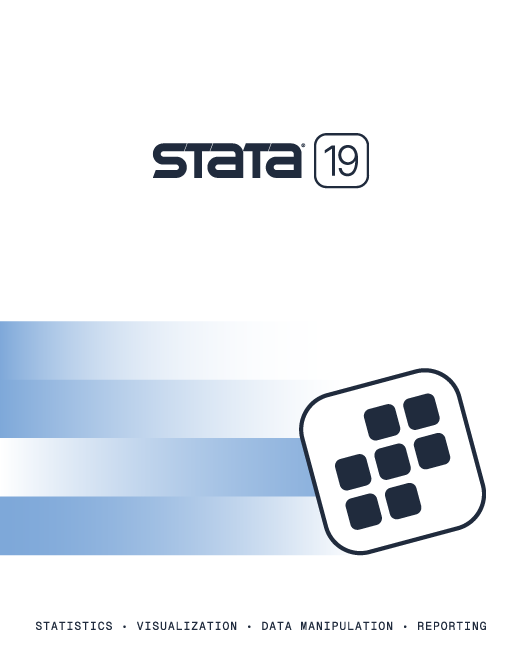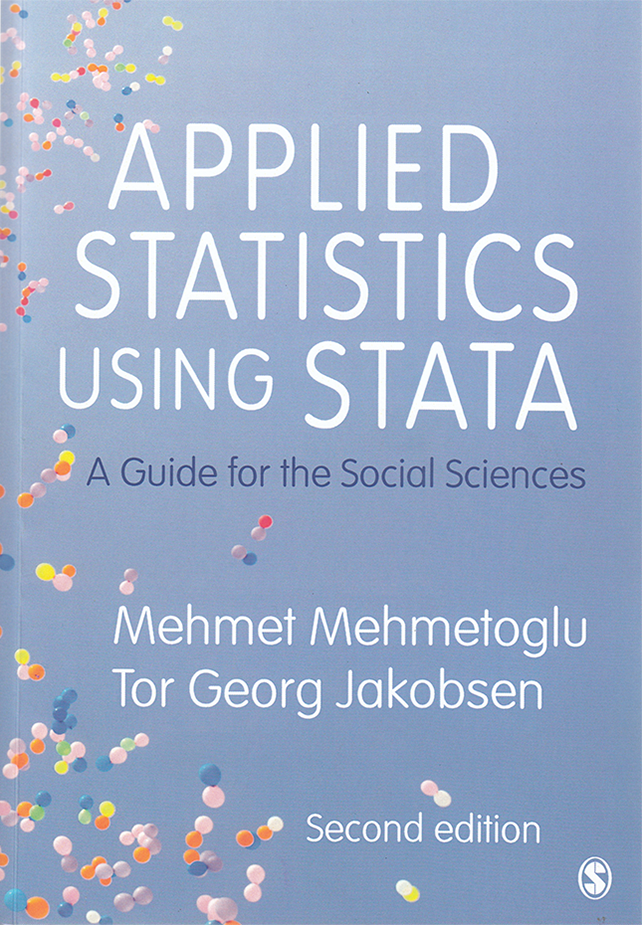

2025 Stata Conference • Nashville, TN • 31 July–01 August
Applied Statistics Using Stata: A Guide for the Social Sciences, Second Edition |
||||||||||||||||||||||||||||||||||||
 Click to enlarge See the back cover |

As an Amazon Associate, StataCorp earns a small referral credit from
qualifying purchases made from affiliate links on our site.
eBook not available for this title
eBook not available for this title |
|
||||||||||||||||||||||||||||||||||
Comment from the Stata technical groupApplied Statistics Using Stata: A Guide for the Social Sciences, Second Edition, by Mehmet Mehmetoglu and Tor Georg Jakobsen, provides an introduction to using Stata for applied statistics. Graduate students from the social sciences, as well as anyone new to quantitative research using Stata, can benefit from this guide. Containing concepts from linear regression analysis to more advanced structural equation modeling, this book will give the reader a broad understanding of how to conduct statistical analysis using Stata. The authors begin by providing readers with a background on statistical concepts and a practical introduction to the applications of Stata. The authors explain critical concepts regarding statistical inference and regression analysis. They then guide the reader through the Stata interface, commands, and resources available for help. After establishing the necessary statistical and software skill sets, the authors cover many statistical models. The authors transition smoothly from linear regression to logistic regression and factor analysis, while discussing the key assumptions related to each model. The authors illustrate each concept with an example using downloadable datasets, allowing readers to perform the sample statistical analyses as they read along. Each example is followed by a detailed interpretation of the statistical output and appropriate postestimation tests. The second edition includes three new chapters devoted to survival analysis, time-series analysis, and programming. In the programming chapter, readers will learn how they can repeat commands over a set of values or variables and learn how to export Stata results and graphs to HTML and Microsoft Word-compatible files. Additionally, the authors include a new chapter devoted to advanced statistical techniques, such as working with missing data, count data, and instrumental variables. Readers looking for additional practice can refer to the new exercises added to each chapter. |
||||||||||||||||||||||||||||||||||||
Table of contentsView table of contents >> Companion Website
About the Authors
Preface
1 RESEARCH AND STATISTICS
1.1 The methodology of statistical research
1.2 The statistical method 1.3 The logic behind statistical inference
1.3.1 Central limit theorem
1.4 General laws and theories1.3.2 t-distribution 1.3.3 Why do I need significance levels if I am investigating the whole population?
1.4.1 Objectivity and critical realism
1.5 Survey data1.6 Quantitative research papers
1.6.1 p-hacking
1.7 Concluding remarksKey terms Questions Practical exercises List of commands Further reading References 2 INTRODUCTION TO STATA
2.1 What is Stata?
2.1.1 The Stata interface
2.2 Entering and importing data into Stata2.1.2 How to use Stata
2.2.1 Entering data
2.3 Data management2.2.2 Importing data
2.3.1 Opening data
2.4 Descriptive statistics and graphs2.3.2 Examining data 2.3.3 Making changes to variables 2.3.4 Generating variables 2.3.5 Subsetting data 2.3.6 Labelling variables
2.4.1 Frequency distributions
2.5 Bivariate inferential statistics2.4.2 Summary statistics 2.4.3 Appending data 2.4.4 Merging data 2.4.5 Reshaping data
2.5.1 Correlation
2.6 Conclusion2.5.2 Independent t-test 2.5.3 Analysis of variance (ANOVA) 2.5.4 Chi-squared test Key terms Questions Practical exercies List of commands Further reading 3 SIMPLE (BIVARIATE) REGRESSION
3.1 What is regression analysis?
3.2 Simple linear regression analysis
3.2.1 Ordinary least squares
3.3 Example in Stata3.2.2 Goodness of fit 3.2.3 Hypothesis test for slope coefficient 3.2.4 Prediction in linear regression 3.4 Conclusion Questions Practical exercise List of commands Further reading References Supplemental Appendix
A3.1 Calculating a bivariate regression
A3.2 Calculating standard errors 4 MULTIPLE REGRESSION
4.1 Multiple linear regression analysis
4.1.1 Estimation
4.2 Example in Stata4.1.2 Goodness of fit and the F-test 4.1.3 Adjusted R² 4.1.4 Partial slope coefficients 4.1.5 Prediction in multiple regression 4.1.6 Standardization and relative importance 4.3 Conclusion Key terms Questions Practical exercises List of commands Further reading References 5 DUMMY-VARIABLE REGRESSION
5.1 Why dummy-variable regression?
5.1.1 Creating dummy variables
5.2 Regression with one dummy variable5.1.2 The logic behind dummy-variable regression
5.2.1 Example in Stata
5.3 Regression with one dummy variable and a covariate
5.3.1 Example in Stata
5.4 Regression with more than one dummy variable
5.4.1 Example in Stata
5.5 Regression with more than one dummy variable and a covariate5.4.2 Comparing the included groups
5.5.1 Example in Stata
5.6 Regression with two separate sets of dummy variables
5.6.1 Example in Stata
5.7 ConclusionKey terms Questions Practical exercise List of commands Further reading References 6 INTERACTION/MODERATION EFFECTS USING REGRESSION
6.1 Interaction/moderation effect
6.2 Product-term approach
6.2.1 Interaction between a continuous predictor and a continuous
moderator
6.3 Conclusion6.2.2 Interaction between a continuous predictor and a dummy moderator 6.2.3 Interaction between a dummy predictor and a dummy moderator 6.2.4 Interaction between a continuous predictor and a polytomous moderator Key terms Questions Practical exercise List of commands Further reading References 7 LINEAR REGRESSION ASSUMPTIONS AND DIAGNOSTICS
7.1 Correct specification of the model
7.1.1 All relevant and no irrelevant X-variables
7.2 Assumptions about residuals7.1.2 Linearity and polynomial regression 7.1.3 Additivity 7.1.4 Absence of multicollinearity
7.2.1 The error term has a conditional mean of zero
7.3 Influential observations7.2.2 Homoskedasticity 7.2.3 Uncorrelated errors 7.2.4 Normally distributed errors
7.3.1 Leverage
7.4 Conclusion7.3.2 DFBETA 7.3.3 Cook's distance Key terms Questions Practical exercise Further reading References 8 LOGISTIC REGRESSION
8.1 What is logistic regression?
8.1.1 Tests of significance
8.2 Assumptions of logistic regression
8.2.1 Example in Stata
8.3 Conditional effects8.4 Diagnostics 8.5 Multinomial logistic regression 8.6 Ordered logistic regression 8.7 Conclusion Key terms Questions Practical exercise Further reading References 9 SURVIVAL ANALYSIS
9.1 Dara structure
9.2 Censoring 9.3 Life table 9.4 Hazard function 9.5 Survival function 9.6 Example in Stata: Life tables with Kaplan-Meier
9.6.1 Kaplan-Meier estimator
9.6.2 Hazard function
9.7 Proportional hazard models (Cox regression)
9.7.1 Assumption of proportional hazard model
9.7.2 Extending the Cox regression model (time-varying covariates)
9.7.3 Multiple events
9.7.4 Competing risks
9.8 ConclusionKey terms Questions Practical exercise List of commands Further reading References 10 MULTILEVEL ANALYSIS
10.1 Multilevel data
10.1.1 Statistical reasons for using multilevel analysis
10.2 Empty or intercept-only model
10.2.1 Example in Stata
10.3 Variance partition (inraclass correlation)10.4 Random intercept model 10.5 Level-2 explanatory variables
10.5.1 How much of the dependent variable is explained?
10.6 Logistic multilevel model10.7 Random coefficient (slope) model 10.8 Interaction efforts 10.9 Three-level models
10.9.1 Cross-classified multilevel model
10.10 Weighting10.11 Post-estimation
10.11.1 Deviation from intercept and random slope regression line
10.12 ConclusionKey terms Questions Practical exercises List of commands Further reading References 11 PANEL DATA ANALYSIS
11.1 Panel data
11.2 Pooled OLS 11.3 Between effects 11.4 Fixed effects (within estimation)
11.4.1 Explaining fixed effects
11.4.2 Summary of fixed effects 11.4.3 Time-fixed effects 11.5 Conclusion Questions Further reading References 12 TIME SERIES ANALYSIS
12.1 Time series
12.1.1 Trends and smoothing
12.2 Autocorrelation12.1.2 How to cope with first-rder autocorrelation
12.2.1 Testing for autocorrelation
12.3 Stationarity12.2.2 How to cope with first-order autocorrelation
12.3.1 Unit roots: testing for non-stationarity
12.4 Time-series models
12.3.2 First difference
12.4.1 Autoregressive models
12.5 Conclusion
12.4.2 ARIMA model (single time series) 12.4.3 Vector autoregression (multiple time series)
Key terms
Questions Practical exercise List of commands Further reading References 13 EXPLORATORY FACTOR ANALYSIS
13.1 What is factor analysis?
13.1.1 What is factor analysis used for?
13.2 The factor analysis process
13.2.1 Extracting the factors
13.3 Composite scores and reliability testing13.2.2 Determining the number of factors 13.2.3 Rotating the factors 13.2.4 Refining and interpreting the factors 13.4 Example in Stata 13.5 Conclusion
Key terms
Questions Practical exercise List of commands Further reading References 14 STRUCTURAL EQUATION MODELLING AND CONFIRMATORY FACTOR ANALYSIS
14.1 What is structural equation modelling?
14.1.1 Types of structural modelling
14.2 Confirmatory factor analysis
14.2.1 Model specification
14.3 Latent path analysis14.2.2 Model identitifcation 14.2.3 Parameter estimation 14.2.4 Model assessment 14.2.5 Model modification
14.3.1 Specification of the LPA model
14.4 Conclusion14.3.2 Measurement part 14.3.3. Structural part
Key terms
Questions Practical exercise List of commands Further reading References 15 COUNT DATA
15.1 Count data
15.1.1 Poisson regression
15.2 Instrumental regression15.1.2 Negative binomial regression
15.2.1 Two-stage estimation
15.3 Transformation of variables15.2.2 Example in Stata
15.3.1 Skewness and kurtosis
15.4 Weighting cases15.3.2 Transformations 15.5 Missing data
15.5.1 Traditional methods for handling missing data
15.6 Conclusion15.5.2 Multiple imputation
Key terms
Questions Practical exercise List of commands Further reading References 16 PROGRAMMING AND DYNAMIC REPORTING USING STATA
16.1 Programming and dynamic reporting using Stata
16.1.1 Macros
16.2 Reproducible and dynamic reporting16.1.2 Loops 16.1.3 If statements 16.1.4 Stored r- and e-class objects 16.1.5 Creating your own Stata command
16.2.1 Dynamic reporting using dyndoc
16.3 Conclusion16.2.2 Dynamic reporting usinig potdocx 16.2.3 dyndoc versus potdocx
Key terms
Questions Practical exercise List of commands Further reading References Index
|
||||||||||||||||||||||||||||||||||||
Learn
Free webinars
NetCourses
Classroom and web training
Organizational training
Video tutorials
Third-party courses
Web resources
Teaching with Stata
© Copyright 1996–2025 StataCorp LLC. All rights reserved.
×
We use cookies to ensure that we give you the best experience on our website—to enhance site navigation, to analyze usage, and to assist in our marketing efforts. By continuing to use our site, you consent to the storing of cookies on your device and agree to delivery of content, including web fonts and JavaScript, from third party web services.
Cookie Settings
Last updated: 16 November 2022
StataCorp LLC (StataCorp) strives to provide our users with exceptional products and services. To do so, we must collect personal information from you. This information is necessary to conduct business with our existing and potential customers. We collect and use this information only where we may legally do so. This policy explains what personal information we collect, how we use it, and what rights you have to that information.
These cookies are essential for our website to function and do not store any personally identifiable information. These cookies cannot be disabled.
This website uses cookies to provide you with a better user experience. A cookie is a small piece of data our website stores on a site visitor's hard drive and accesses each time you visit so we can improve your access to our site, better understand how you use our site, and serve you content that may be of interest to you. For instance, we store a cookie when you log in to our shopping cart so that we can maintain your shopping cart should you not complete checkout. These cookies do not directly store your personal information, but they do support the ability to uniquely identify your internet browser and device.
Please note: Clearing your browser cookies at any time will undo preferences saved here. The option selected here will apply only to the device you are currently using.